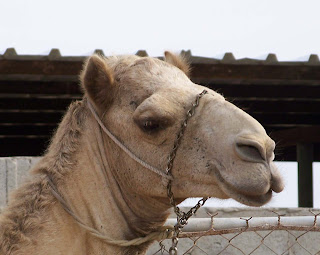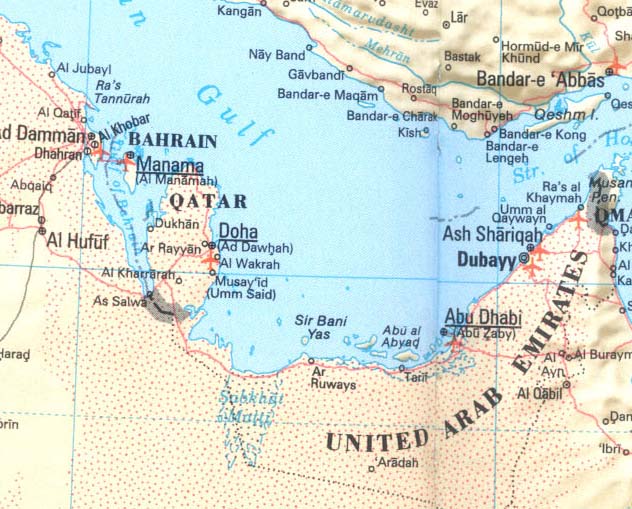
Part of my excursion last week was to the camel race track at Al Shahaniyah. This image of a camel handler controlling four camels and a cellphone vividly demonstrates the antiquity and the modernity. From the government web site on camel races,
Camel race is an exciting sport, for which Qataris have exceptionally high regard and appreciation. It stands for originality, most esteemed heritage, honorable, competitiveness, excitement and speed. In light of that and in recognition of the importance of the practice, H.H the Emir and H.H the Heir Apparent issued the directives to hold camel races on annual basis. By encouraging this sport, they also sought to highlight the popular heritage, conserve the authentic Arabic traditions and remind the youths of the era of glory and the sport of forefathers. …The Camel Race Committee is responsible for supervising the camel races. There are two breeds of camels in Qatar; one is the Qatari and the Omani and the other is the Sudanese. Sudanese camels have come directly from the Sudan across Saudi Arabia. They are characterized by their speed and agility while the Arabian breeds are characterized by their strength and endurance. Fast camels are useless without a skilful trainer. …The first ever camel racetrack to have been built in Qatar is the one at Al Abgah, which was established according to the directives of H.H the Emir. Races continued to be held at this 16-km long track until late 1989, when the number of entries to the race increased beyond its capacity and when H.H the Emir ordered the establishment of the present camel racetrack at Al Shahaniyah. Races on Al Shahaniyah track started in 1990 with all 6, 8 and 10-km race categories. The auditorium has a main terrace, a veterinary clinic, modern stalls for camels, a big mosque and large water tanks.
What follows are portraits, of camels and of camel handlers. The camels are very interesting as our retiring Dean of Medical Education explained. Their hare lip (seen in the portraits) is critical for eating and in fact the two sides are used as our fingers are. The narrow eyes, also seen, are critical for closing during sand storms. Seen readily on the image is the fifth foot, on the sternum. For years, this hard patch was believed to have been caused by the action of camels resting on their chest. In fact, as our expert revealed, when he dissected a camel embryo, he saw the same structure and realized that it didn’t develop during life but was there from the beginning.

Camel race is an exciting sport, for which Qataris have exceptionally high regard and appreciation. It stands for originality, most esteemed heritage, honorable, competitiveness, excitement and speed. In light of that and in recognition of the importance of the practice, H.H the Emir and H.H the Heir Apparent issued the directives to hold camel races on annual basis. By encouraging this sport, they also sought to highlight the popular heritage, conserve the authentic Arabic traditions and remind the youths of the era of glory and the sport of forefathers. …The Camel Race Committee is responsible for supervising the camel races. There are two breeds of camels in Qatar; one is the Qatari and the Omani and the other is the Sudanese. Sudanese camels have come directly from the Sudan across Saudi Arabia. They are characterized by their speed and agility while the Arabian breeds are characterized by their strength and endurance. Fast camels are useless without a skilful trainer. …The first ever camel racetrack to have been built in Qatar is the one at Al Abgah, which was established according to the directives of H.H the Emir. Races continued to be held at this 16-km long track until late 1989, when the number of entries to the race increased beyond its capacity and when H.H the Emir ordered the establishment of the present camel racetrack at Al Shahaniyah. Races on Al Shahaniyah track started in 1990 with all 6, 8 and 10-km race categories. The auditorium has a main terrace, a veterinary clinic, modern stalls for camels, a big mosque and large water tanks.
What follows are portraits, of camels and of camel handlers. The camels are very interesting as our retiring Dean of Medical Education explained. Their hare lip (seen in the portraits) is critical for eating and in fact the two sides are used as our fingers are. The narrow eyes, also seen, are critical for closing during sand storms. Seen readily on the image is the fifth foot, on the sternum. For years, this hard patch was believed to have been caused by the action of camels resting on their chest. In fact, as our expert revealed, when he dissected a camel embryo, he saw the same structure and realized that it didn’t develop during life but was there from the beginning.


First the camels, together and alone:













